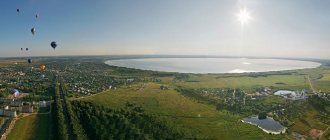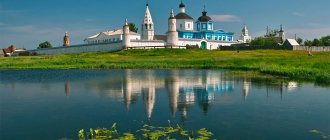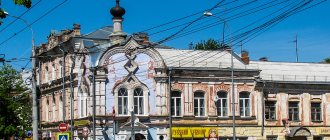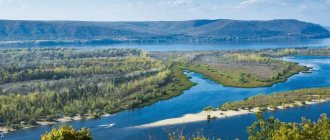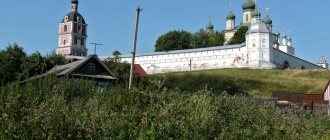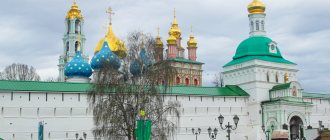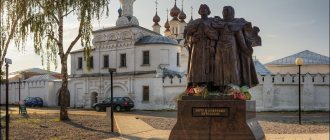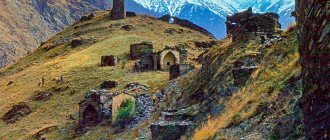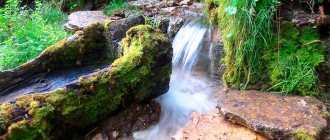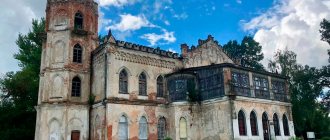Pereslavl-Zalessky is one of the most interesting cities of the Golden Ring , and on our website you will find quite a lot of materials about this city. But until today, unfortunately, there was no article on it that would tell in detail about the sights of Pereslavl with photos and descriptions, and would also provide a map on which they would all be marked - this would greatly facilitate the process of developing a route around the city. We decided to correct this misunderstanding and, within the framework of one post, combine all the sights of the city so that readers would not have the question “What to see in Pereslavl-Zalessky?” But first, just a few words about organizational issues: how to get there and where to stay.
Sights of Pereslavl-Zalessky on the map
Pereslavl-Zalessky is one of the oldest and most picturesque cities included in the Golden Ring of Russia and more than once played a significant role in the history of Ancient Russia, the Principality of Moscow and the Russian Empire at the time of its formation and the struggle for dominance on the shores of the Black and Baltic Seas.
Founded in 1152 by Yuri Dolgoruky, Pereslavl-Zalessky already in the early times of its history was striking in scale - the length of the city defensive rampart exceeded 2.5 km. It was the third largest city of the Old Russian state , second only to Kiev and Smolensk! And in the period from 1267 to 1294 it performed the functions of the capital of North-Eastern Rus', which significantly increased the influence of the city on the cultural life of the region. In 1280, it was here that a council of the leading hierarchs of North-Eastern Rus', Metropolitan Kirill III and Grand Duke Dmitry of Pereyaslavl, met.
The rise of Moscow and the process of beginning to gather Russian lands around it began with the annexation of Pereslavl-Zalessky to the Moscow Principality . According to the will of the last appanage prince of the Pereyaslavl land, Ivan Dmitrievich, all his possessions went to Moscow. The neighbors categorically disagreed with this - especially the Tver princes - who suffered their first defeat in the war for the right to become the capital of the future Russia precisely under the walls of Pereslavl-Zalessky.
Despite the lack of access to the sea, Pereslavl-Zalessky played a vital role in the formation and development of the Russian navy . On Lake Pleshcheyevo, on the shores of which the city is located, the amusing flotilla of Peter I was laid down, which served as the prototype of the future Navy, which entered and still holds its place among the three most formidable naval forces in the world.
Pereslavl-Zalessky is a real religious pearl of the Golden Ring of Russia. There are several ancient Orthodox monasteries , unique churches preserved from the times of Ancient Russia, as well as authentic objects of the pagan cult of the Slavic tribes that once inhabited the coast of Lake Pleshcheyevo.
Streets of Pereslavl
Pereslavl is small, but there are a lot of temples and monasteries visible from different parts of the city, so even a short walk will be enriched by the views.
You will be delighted by Rybnaya Sloboda : most of the paintings and drawings on boxes that are offered in Pereslavl as souvenirs depict landscapes of Rybnaya Sloboda. It is called “Russian Venice,” which does not really fit with its real name.
The areas of ancient streets and houses in the spirit of Russian architecture on the shores of the lake are becoming smaller and smaller due to the construction of modern cottages, so it is better to visit the settlement before it turns into an area of typical cottage development.
In Sokolskaya Sloboda you will find another monastery built in the 16th century: Holy Trinity Danilovsky . The monastery was erected in honor of the birth of Ivan the Terrible, and this dedication seemed to leave an imprint on the appearance of the monastery: severity, some architectural heaviness are reminiscent of the character of the famous Russian Tsar.
Going to Red Square, take a walk along the ancient earthen rampart : from there you can see the lake and the heads of the monasteries on the other side melting in the fog.
Transfiguration Cathedral
The Transfiguration Cathedral is a unique architectural object of high value for the cultural heritage of Russia. This is the only white-stone temple in North-Eastern Russia that has come down to us almost completely intact . It was founded in 1152 by Yuri Dolgoruky and is a small ascetic building. In the pre-Mongol period of Russian history, the Transfiguration Cathedral had a rather rich interior decoration, most of which has not survived to our time - numerous fires and devastation of Pereslavl-Zalessky destroyed unique artifacts. The most ancient value that has survived to this day is the “Transfiguration” icon of the 14th century, presumably the work of Theophanes the Greek .
Today it is kept in the Moscow Tretyakov Gallery, and an exact copy is located in the cathedral. Address : Red Square, building 1A, Pereslavl-Zalessky, Yaroslavl region, 152020
The main attractions of Pereslavl-Zalessky: TOP-5
Images of many business cards of the ancient policy are well known to Russians from illustrations in history textbooks or advertising brochures. These attractions top the rating of all the interesting things that travelers can see in Pereslavl-Zalessky.
Transfiguration Cathedral
- Address: Red Square, 1A. Transport stop "LIT Plant".
The majestic temple is rightly considered the main historical and architectural landmark of Pereslavl-Zalessky. And the point is not only that the cathedral, consecrated in 1157, was founded by Yuri Dolgoruky himself, and Andrei Bogolyubsky completed the construction. Some tourists are surprised to learn that the Grand Duke-commander Alexander Nevsky was baptized in the shadow of the church. In addition, the appearance of the building reflected all the best inherent in ancient Russian religious architecture. The 22-meter cathedral delights with its majestic ascetic decor and ideal proportionality of forms. The only surviving representative of the five first temples built in Rus' from white stone is an invaluable historical monument. Once upon a time, the walls of the church were decorated with delightful frescoes that were lost in the 19th century. The later, lurid painting was also removed over time. Now the walls of the cathedral are whitewashed. Its interior is awe-inspiring in its austere simplicity. The only decorations of the interior are an elegant marble altar and a masterful copy of the temple icon, painted in his time by Theophanes the Greek himself. The original of the ancient image today adorns one of the halls of the Tretyakov Gallery in Moscow .
Pereslavl Kremlin
- Address: historical city center. Transport stop "Prosecutor's Office".
Today, the Kremlin is usually called the part of the historical center of the city, in which the iconic architectural sights of Pereslavl-Zalessky are concentrated. But it was not always so. Since the reign of Yuri Dolgoruky, the policy was protected by powerful walls and an impressive earthen rampart. The remains of a 2-kilometer-long embankment fortification, reaching a height of 12 m in places, are clearly visible even now. The fortress was destroyed several times, in particular by the Horde armies of Tokhtamysh and Edigei, but was quickly restored. The last time the wooden walls and towers of the citadel were renewed was in the middle of the 17th century. After another 100 years, the fortifications were finally demolished due to the loss of their defensive purpose. The Transfiguration Cathedral and part of the buildings of the Novodevichy Sretensky Monastery have survived to this day from the complex of Kremlin buildings.
Lake Pleshcheyevo
The ancient reservoir, formed by retreating glaciers almost 30 thousand years ago, is the main miraculous decoration of Pereslavl-Zalessky and an iconic landmark of the entire Yaroslavl region. The lake, covering an area of approximately 51 km², is very beautiful. Its waters are home to the famous vendace, and its shores are frequented by cranes, seagulls, ducks, and herons.
Walking along the northeastern shore of the picturesque reservoir, you can admire a unique monument from the period of pre-Christian Rus'. Here lies the Sin-stone - the object of worship of the distant ancestors of today's Pereslavl residents. The boulder was brought to this place from the vicinity of the Nadozernaya Borisoglebsk monastery at the end of the 18th century. Before this, the monks, who considered the stone a devilish attribute, tried in every possible way to get rid of it. They even buried the monolith, but each time the earth pushed out a piece of rock from its depths. The 12-ton Blue Stone has a remarkable feature. The gray quartz shale of which it is composed turns blue after every rain.
Red Square
- Address: recreation in the city center. Transport stop "LIT Plant".
The architectural ensemble of the main square of the city cannot but arouse admiration. Everything here is thought out to the smallest detail. The dominant feature of the composition is the coldly majestic Church of the Transfiguration. Its solemn asceticism is harmoniously complemented by the elegant Alexander and colorful Metropolitan churches. Recreation is not without monumental decorations. A monument to Alexander Nevsky was erected on the square, and a memorial to the Pereslavl Bolsheviks was built. In 1972, another unusual attraction appeared here - an analogue of the Sin-stone, lying on the shore of Lake Pleshcheevo. A gray-blue boulder was lifted from the bottom of the reservoir.
Goritsky Monastery
- Opening hours: from 10:00 to 18:00 from May to September inclusive, at other times from 10:00 to 17:00.
- Ticket price: single adult 500 rubles, reduced price 300 rubles, children 250 rubles.
- Telephone.
- Website: https://museumpereslavl.ru
- Address: Museum Lane, 4. Transport stop "Podgornaya".
The history of the monastery, founded during the reign of Ivan Kalita, is full of dramatic twists and turns. Suffice it to say that in 1382 the monastery was completely destroyed by the darkness of Khan Tokhtamysh. Then the cult complex was quickly restored, thanks to Dmitry Donskoy’s wife, Princess Evdokia. After another 400 years, the monastery was abolished. The hierarchs of the Pereslavl diocese settled within its walls, expelled after the revolution by the Bolsheviks, who turned the monastery into a museum. The oldest building of the white stone complex, which is one of the main attractions of Pereslavl-Zalesk, is considered to be the Assumption Cathedral, built in 1750. Later, the All Saints and Epiphany Churches and the current St. Nicholas Church were erected. The architectural ensemble, surrounded by a high wall with towers, is complemented by the buildings of the Theological School, Belfry, Holy Gate, and the Intercession Chapel, transported from the village of Starovo. Now the former monastery houses most of the exhibition of the Pereslavl-Zalessky Museum-Reserve.
St. Nicholas Convent
St. Nicholas Convent is one of the most important and most visited attractions of Pereslavl-Zalessky, which is the architectural dominant of the city , whose golden domes are visible from any part of it. According to legend, the monastery was founded by Dmitry Prilutsky, one of the students of Sergius of Radonezh. Over its long history, the St. Nicholas Convent went bankrupt more than once. But the most difficult time for the religious complex was the period of Soviet power in Russia. The monastery was closed and its main cathedral and bell tower were blown up .
Only in 1994 did the period of spiritual revival of the monastery and restoration of lost architectural objects begin. The main shrine of the St. Nicholas Monastery is the ancient Korsun cross , according to legend associated with the story of Vladimir the Red Sun and the baptism of Russia in 988. According to researchers, this cross was transferred from Korsun to Kyiv under Prince Vladimir, and in the 11th century it came to the Vladimir-Suzdal lands. Under Dmitry Donskoy and Ivan the Terrible, the cross was decorated with gems, and since the 17th century it has been in the Pereslavl St. Nicholas Monastery.
Address : st. Gagarina, 43, Pereslavl-Zalessky, Yaroslavl region, 152020
Blue stone
The most famous object of the pagan cult of the ancient Slavs on the territory of Pereslavl-Zalessky is the Blue Stone, presumably located on the site of an ancient temple.
The huge boulder, which many of us missed and passed by, is surrounded by many legends. The most important one says that after the baptism of Rus', Christians more than once threw the Sin-stone into the water of Lake Pleshcheevo. In this way they tried to stop the worship of pagan cults and finally break the influence of the priests on the local population. But each time the boulder “mysteriously” returned to the place where it has been located for the last few centuries. Address : Kriushkino, Yaroslavl region, 152040
When is the best time to go to Pereslavl-Zalessky
The best time to organize a trip to the ancient Russian city is summer:
- no sweltering heat;
- Lake Pleshcheyevo is warming up quickly;
- the entire tourism infrastructure is actively working;
- there is an opportunity to visit Sin-kamen;
- a small number of blood-sucking insects.
The winter period will also bring many memorable impressions:
- the atmosphere of Russian Christmas festivities;
- the opportunity to visit all interesting museums without distractions;
- Snow kiting lessons on the lake.
Experienced travelers do not recommend coming to the city in spring and autumn. The unusually beautiful autumn landscapes and the spring awakening of nature are overshadowed by constant rain and great dampness. Roads, which in many places are not paved, limit travel options.
Museum-estate "Boat of Peter I"
Lake Pleshcheyevo, on whose shores Pereslavl-Zalessky is located, is the cradle of the Russian navy . It was here that young Peter I built his “amusing” fleet and laid the foundations for a future formidable force that such powers as Sweden, Turkey, England and France had to reckon with. The most sacred place and the main exhibit of the museum is the boat of Peter I - the famous large wooden boat “Fortune” of the young Tsar .
The boat, designed for 10 rowers and 10 passengers and intended for transporting passengers and cargo to warships, occupies almost the entire space of the small hangar built for it. Address : Botik town, Veskovo, Pereslavl district, Yaroslavl region, 152021
Museum of Cunning and Ingenuity
On the territory of Pereslavl-Zalessky there are many private museums, among which the most original is the Museum of Cunning and Ingenuity. The attractive name and truly unusual exhibits do not allow many visitors to the city to pass by. The museum's exposition is a collection of funny and very useful household items, invented by savvy residents of villages and provincial towns to make life easier and entertain children . Here you can find:
- Prototypes of modern juicers
- Musical bottles
- Pest traps
- Cups for mustachioed men
- Equipment for cracking nuts, etc.
some exhibits in your hands and even check their functionality in action .
Address : st. 152020, Sovetskaya st., 14, Pereslavl-Zalessky, Yaroslavl region, 152020
Lake Pleshcheyevo
Lake Pleshcheyevo is the main attraction of the city , attracting not only tourists, but also local residents. of the Russian navy - it was its water surface that was cut through by the amusing flotilla of Peter I. In addition, Lake Pleshcheyevo has very high biological productivity and a wide variety of fish. In a relatively small reservoir - only 9.5 by 6.5 km of maximum length and width - there are 16 species of fish, among which the Pereslavl vendace , which has become the “calling card” of Pereslavl-Zalessky and is well sold by numerous tourists, is of particular interest.
Lake Pleshchevo is also a popular place for water sports. The reservoir is especially popular among kitesurfers, windsurfers and snowkiters . On the shore of the lake there are a huge number of attractions of Pereslavl-Zalessky - Botik of Peter I, Nikitsky Monastery, Blue Stone, as well as the site of archaeological excavations of the first settlements of the Merya tribe.
Address : lake, Pleshcheyevo, Yaroslavl region, 152024
FAQ
What attractions near Pereslavl-Zalessky can you visit by car? Museum-Estate "Boat of Peter I", Museum of the Teapot, Nikitsky Monastery, Alexandrov Mountain, Pleshcheyevo Lake National Park, Blue Stone, St. Barbara's Source, Railway Museum, Museum "Birth of a Fairy Tale", Museum of Gramophones and Records.
can you go with children in Pereslavl-Zalessk “Berendey’s House”, Iron Museum, Museum of Cunning and Ingenuity, Arboretum of S. F. Kharitonov, Russian Park, Alexander Nevsky Museum.
Top attractions of Pereslavl-Zalessky Cathedral of the Vladimir Icon of the Mother of God of the Presentation, Goritsky Monastery, “Berendey's House”, Pereslavl-Zalessky Museum-Reserve, St. Nicholas Monastery, Pereslavl-Zalessky Kremlin.
Iron Museum
One of the most popular private museums in Pereslavl-Zalessky is an exhibition dedicated to an ordinary household item - an iron.
There are about 200 exhibits from the “pre-electric era” in the private collection. Here you can see irons powered by hot coals, alcohol and gas models, and the first electric models. The collection also contains the “progenitors” of an indispensable device in everyday life – a rolling pin and a ruble. All models shown are in working condition and were collected from all over the country. Some irons were bought at flea markets, some were in trash heaps and were repaired. The collection also includes foreign models - from Poland, Germany and other European countries. Once a year the museum organizes an Iron Festival, when you can see all the copies in action.
Address : Sovetskaya st., 11, Pereslavl-Zalessky, Yaroslavl region, 152020
How to get to Pereslavl-Zalessky from Moscow
How to get to Pereslavl-Zalessky by car
Pereslavl Zalessky is located just 150 km from Moscow; the easiest way to get there by car is along the M8 Kholmogory highway (Yaroslavskoye Highway). You drive straight all the time, there are many signs along the way, so you don’t get lost.
How to get to Pereslavl by public transport
Buses depart from the Shchelkovsky bus station daily; you can get there both on direct routes and on those buses that go to Yaroslavl or Rybinsk. There is no railway station in Pereslavl, the nearest station is 18 km from the city - the Berendeevo platform, and further by taxi or local buses.
Temple of the Forty Martyrs of Sebaste
The picturesque temple, located at the mouth of the Trubezh River, attracts primarily with its amazing landscapes , especially beautiful in the rays of the setting sun. The temple was consecrated in honor of 40 Roman legionnaires who suffered martyrdom in the name of the Christian faith in the 3rd century AD.
The first mention of the church dates back to the 17th century - in the patriarchal salary books under 1628 it is written: “Church of the Saints Forty Martyrs, in the settlement, tribute eight altyns, four money, ten-dollar hryvnia.” The exact date of construction is unknown - historians suggest that it was at the turn of the 15th-17th centuries. The stone building of the temple, which has survived to this day, was erected in 1755 with the personal funds of the Moscow merchants Shchelyagins . At the beginning of the 19th century, the church experienced a major fire, as a result of which all the frescoes and historical paintings of the temple were destroyed. What parishioners and tourists see now was finally restored at the beginning of the 21st century. During the years of Soviet power, the Temple of the Forty Martyrs of Sebaste was closed and repurposed as a rescue station. Its rediscovery as a religious site took place in 1995, however, to this day it serves as a beacon on Lake Pleshcheyevo for fishermen who did not have time to return to the shore before dark or went out fishing at night.
Address : Levaya Naberezhnaya st., 165, Pereslavl-Zalessky, Yaroslavl region, 152020
Sights of the city and surrounding area
Lake Pleshcheyevo
Popular rumor says that the lake got its name from the peculiarity of throwing away all objects that fall into its waters. Historians are inclined to believe that this is a modern modification of the old name of the city of Kleshchina, which stood on the site of Pereslavl-Zalessky.
The ancient reservoir, which is about 30 thousand years old, covers an area of 51 hectares, is distinguished by clear, clean water and a sandy bottom.
The gently sloping, low shores are accessible to humans, and the depths in some places reach 25 m. This is one of the most attractive places in Central Russia, where you can relax, go fishing, take a boat trip and engage in water sports: windsurfing, kite surfing and snow kiting are popular on the lake.
The lake is part of the National Monument of the same name and is a Cultural Heritage Site of regional significance. This is where the history of the Russian fleet begins: in the 17th century, the young Tsar Peter organized his “Amusement Flotilla” on the lake. There are a large number of local attractions along the coast.
Pereslavl Museum-Reserve
The year the reserve was founded is 1919. The exhibition consists of 80 thousand units, occupies the buildings of the Goritsky Monastery and is located in the villages of Gorki and Vaskovo.
The museum includes:
- museum-estate of the Ganshins;
- Kardovsky Art Gallery;
- Museum "Boat of Peter I";
- Transfiguration Cathedral"
- exhibition areas (permanent and temporary) showing: painting, wood carving and sculpture, the natural world; history of Pereslavl;
- ancient icons.
Transfiguration Cathedral
The pearl of Russian church architecture - the single-domed Spaso-Preobrazhensky Church, in which the patron of the city, Prince Alexander Nevsky, was baptized - is located on Red Square of the city Kremlin. The founder of the temple in 1152 They think Yuri Dolgoruky. The cathedral is one of the most ancient stone churches in our country.
The interior of the temple is surprisingly ascetic: white walls, lack of usual decor. Only a marble altar and a copy of a temple icon from the 15th century. “Transfiguration” by F. Grek (the original is kept in the Tretyakov Gallery).
Over its long life, the temple was remodeled more than once, but it retained the special spirit of Russian Orthodox architecture. The restoration, which is currently underway, limits visits to the cathedral only to significant church holidays: 19.08, 12.06, 12.09.
Vladimir Cathedral and Alexander Nevsky Church
On the site of the Sretensky Novodevichy Convent in the city center there are three churches nearby: the Spaso-Preobrazhensky Cathedral, the Vladimir Cathedral and the Church of Alexander Nevsky. The red and white baroque Vladimir Cathedral was built in the 17th century. with the money of the merchant F. Ugrimy. It became the main temple of the city.
The churches survived the years of Soviet power, turning into bakeries and gyms. Fortunately, the holy buildings escaped destruction: in 1936 they were recognized as an architectural heritage. The Vladimir Cathedral is under restoration, but services go on and sometimes they organize exhibitions of photos, paintings, and archaeological finds.
Don't miss the most popular article in the section: Metro Nizhny Novgorod. Diagram, map, description.
Church of Peter the Metropolitan
Metropolitan Peter is considered the heavenly patron of Russia. His holy relics have been kept for 700 years in the Assumption Cathedral of the Kremlin in Moscow, and in Pereslavl-Zalessky in the 14th century. A wooden temple was founded in his honor. At the end of the 1580s, the wooden structure was replaced with a stone one on the initiative of Ivan the Terrible, who, by building the temple, tried to atone for the murder of his son.
The church, closed in 1940, has been restored for many years. The tented architecture of the temple, rare for these places, invariably attracts tourists. On patronal holidays, services are held and on these days it is possible to get to the temple.
Church of the Forty Martyrs
The contrasting red and white five-domed Church of the Forty Sebastian Martyrs was built in 1755. This is the “postcard” symbol of Pereslyavl-Zalessky. The church at the mouth of the Trubezh River serves as a kind of beacon for fishermen and vacationers. During the years of the USSR, the church “worked” as a rescue station.
Services were resumed in 1995. Restorations in recent years have restored the paintings on the walls of the church, which were destroyed in a fire in 1919. The relics of Admiral Fyodor Ushakov and 40 Roman peasant martyrs are the main shrines of the temple. There is an observation deck around the church overlooking the lake.
Nikolsky Convent
The Korsun cross is the main shrine of the St. Nicholas Monastery - one of 10 crosses brought by Prince Vladimir from Chersonesos. It is now on display in the city's historical museum. Monastery founded in the 14th century. Reverend Dmitry Prilutsky, was destroyed many times during wars and raids.
The last misfortune was the closure of the monastery in 1920, when the main cathedral was blown up, and the monastery buildings were converted into apartments, workshops and barnyards. The monastery, which was returned to the church at the end of the last century, had to be rebuilt. Nowadays the monastery is for women and in it you can get acquainted with the preserved old buildings - the Annunciation and the Church of Peter and Paul.
Nikitsky Monastery
Prince Boris Vladimirovich, in order to overcome paganism among the local population, built a monastery on the shore of Lake Pleshcheevo. Chronicles indicate the date of foundation - 1010, which makes it the oldest monastery in the North-Eastern regions of Russia, the history of which is connected with the name of Nikita the Stylite.
The buildings of the 16th-19th centuries have been preserved in the ensemble of the monastery to this day. In the fence, guests can see and visit the Cathedral of the Great Martyr Nikita (XVI century), the Annunciation Church and the Refectory, the tented bell tower, and the new gate temple of the Archangel Gabriel.
Men's Holy Trinity Danilov Monastery
The monk of the Nikitsky Monastery, Daniel, founded the Lavra in 1508, where in 1530 the Trinity Cathedral was built in honor of the birth of the heir (the future Ivan the Terrible). The Lavra had vast lands and acted as a respectable feudal lord. During the Time of Troubles and after the revolution, the monastery suffered greatly and was closed in 1923. It was returned to the church in the late 1990s and has been restored since then.
Holy Trinity Danilov Monastery in Pereslavl-Zalessky
On the territory of the monastery you can visit the Trinity Cathedral (recently restored), the Four-Pillar Church with paintings by Gury Nikitin (only in the warm season) and the elegant Tikhvin Church - a wonderful example of Russian church architecture.
Feodorovsky Convent
Where the Moscow and Tver squads met on the battlefield in 1304, a monastery was founded on the day of memory of Theodore Stratilates. Monks lived in it for two centuries, and in subsequent years the monastery became a women's monastery. The Soviet period brought devastation and oblivion here: a colony, a nursing home and a construction organization were located here.
In the 2000s, a period of recovery begins. Clean air, peace and grace help you to detach yourself from everyday worries and find peace of mind.
The main temple is the Feodorovskaya Church, which appeared in the 16th century. in honor of the birth of Ivan the Terrible's son Fedor. The monastery buildings are visible far away: golden domes, green domes, white walls.
Numerous pilgrims come here to touch the miraculous Andronnikov Icon of the Mother of God. In addition to the main temple, you can visit the Vvedenskaya and Kazan churches, built in the 18th century.
Museum-estate "Boat of Peter I"
Pereslavl-Zalessky, the sights, photos and descriptions of which will not convey the entire atmosphere of the city, begins to be explored from the first museum of the Russian province - “The Boat of Peter I”, which was founded in 1803.
The main exhibit of the museum is the boat “Fortune”, built by the Tsar himself. The ship is located in the Boat House. The complex also includes a rotunda, the White Palace, a gatehouse, triumphal votos, a monument to Peter the Great and an obelisk. The museum complex is located 4 km from the city in the village of Veskovo.
Pereslavl Railway Museum
Pereslavl-Zalessky is famous for its preserved narrow-gauge road, which is its landmark. The private museum, which welcomed visitors in 1991, collected rail transport of the 19th-20th centuries and everything that is in one way or another connected with the railway: locomotives, carriages, steam locomotives, railcars, semaphores, switches, old documents and photos.
You can also get acquainted with cars and motorcycles from 1900-1950. Sometimes it is called the “Cuckoo” museum, after the name of small steam locomotives for narrow-gauge roads. Many exhibits have been preserved in single copies. Near each there is a sign with a description.
The museum occupies the old depot buildings and access roads. Some of the equipment is at the restoration stage, but many exhibits have been restored to working condition.
Iron Museum
The museum, which tells about one of the most useful household appliances, is one of the most visited. It was located in an old mansion in 2002 and for the first two years it worked for free.
Now the cost of visiting is a small amount, as in other museums in the city. The collection includes more than 200 irons, varying in age, size and technical complexity. Exhibits appear regularly, entering the museum from the most unexpected places.
Teapot House Museum
Teapots from all over our country “settled” in a bright blue house on the street. Podgornaya. The private museum occupies the premises of a former residential building and has an exhibition of 130 copper, porcelain, shiny and rusty, tall and squat vessels for brewing tea.
The museum will lift the spirits of every visitor:
- signs with creative calls and slogans surround guests;
- there is an opportunity to see a “Bird” teapot in the shape of a swan, a huge 15 liter teapot for a working arteole, a sea kettle that does not splash out water when pumping, a hybrid of a samovar with a kettle;
- nostalgia will be evoked by a bust of Lenin and a pioneer tie, a moonshine still and an old radio;
- The excursion, which takes place under the soft music of an old gramophone, will tell you about tea traditions and the history of this drink.
Museum of Peasant Design “Horse in a Coat”
Stone chambers of the 12th century. on the street Horse-drawn, in the very center of the city, are the best suited for the ethnographic museum located there with a memorable, extraordinary name. The exhibition tries to connect the past with the present, antiquities with computer technology.
The exhibitions are based on handmade items from peasants of the 17th-19th centuries: jewelry, textiles, tiles, paintings and carvings, forged items. The museum will be interesting to visit for guests of all ages.
Radio Museum
The small private museum dedicated to radio is very popular. It was organized through the efforts of collector G.P. Semenov, occupies two floors and introduces guests to radio, video, and television equipment of all times and countries. The museum owns instruments of which there are only a few left in the world.
The exhibits were received from residents and found in landfills, attics and abandoned houses:
- military trophy - German Blaupunkt 1938,
- the legendary KVN-49;
- the first video recorders;
- loudspeakers;
- home radio devices.
It is possible to purchase parts for repairing vintage receivers here.
Museum of Old Sewing Machines
Residents of Pereslavl-Zalessky, the Kuvykina spouses went down in the history of the city as the founders of a unique museum of sewing machines. Now the museum collection includes more than 100 cars of the 17th - 21st centuries, both domestic and imported from Europe and America.
Most of the exhibits are working and visitors are given the opportunity to test their sewing skills. The museum conducts excursions and tells about the history of sewing, great people and manufacturing companies of world brands. On the ground floor you can drink coffee and buy souvenirs.
Alexander Nevsky Museum
Pereslavl-Zalessky, the sights, photos and descriptions of which can be studied in this article, has many young exhibitions, including the Alexander Nevsky Museum, opened in 2012.
The wooden building looks cozy and compact. The exhibits are dedicated to the historical period associated with the reign of Prince Alexander in Pereslavl. Talented guides will help you dive into the depths of centuries and tell you little-known facts.
The museum exhibits:
- figures of warriors of the 10th-12th centuries - a knight in Teutonic armor, a Mongol horseman, a Russian knight;
- Prince Nevsky on icons;
- model of the city from the 12th century;
- awards dedicated to the name of Alexander Nevsky.
Museum of Cunning and Ingenuity
The small museum, founded by Oleg Gunderin in 2011, occupies only one room.
The museum’s exhibits represent the endless creativity and ingenuity for which the Russian people have always been famous:
- bottle refrigerator;
- traps for garden pests;
- ancient steelyards;
- dishes for those with a bushy mustache;
- nut crackers;
- cane-stool.
The collection of exhibits for the museum does not stop and the collection is constantly growing: antique irons, clothes, hair locks, washstands, lanterns and many more household items that were used by distant ancestors.
"Russian Park"
The historical and cultural center, which is located on an area of several hectares, is of interest to both adults and children.
This is a world of traditions and customs, an opportunity to touch the culture of the Russian people of the 19th-20th centuries:
- The Cossack yard will provide an opportunity to try throwing an ax and cracking a whip. Here you can harness and saddle a horse, ride a cart and ride on horseback.
- The Russian village shows ancient huts with platbands, ridges and paintings. The houses are open to the public; they create the atmosphere of life in a Russian village of the 19th-20th centuries.
- In the huts there is an opportunity to get acquainted with thematic exhibitions of birdhouses, folk musical instruments, spinning wheels, bast shoes, popular prints, and wickerwork.
- In the Russian Fashion Museum, everyone has the opportunity to try on ancient outfits and play the role of the owner of the estate.
- The "Vendace" tavern will feed travelers with royal borscht made from 5 types of meat (menu of Emperor Alexander I), the famous Guryev porridge and chicken prepared according to the recipes of A. Dumas.
- Anyone who visits the museum “What the Russians were the first to invent in the world” will feel pride in their country and people. Few people know that gypsum, Tetris and more than 200 other discoveries belong to Russians.
- Tasting various types of tea, including traditional village herbal teas and Russian kvass, will help quench your thirst and learn the secrets of their preparation.
- The alleys of the park present open-air exhibitions: frames and flags of Russia from the 9th century, Russian fonts and folk crafts.
- For kids there is a petting zoo, a playground and a Glade of Fairy Tales. Experienced teachers conduct master classes in modeling, sewing, and painting.
- Weekends will delight visitors with theatrical performances on various topics.
Entrance to the park is paid from the age of 7. For an additional fee, it is possible to order excursion services.
"Berendey's House"
Pereslavl-Zalessky, the sights, photos and descriptions of which are best not studied before the trip, so as not to weaken the impression of the city, introduces tourists to the homeland of the most famous and wise Tsar Berendey.
The Royal Chambers is a cultural area in the city center with its own museum, a stylized cafe “Tsar Berendey’s Refectory” and a souvenir shop.
Excursions, master classes, and interactive programs tell about the traditional way of life of a Russian village and provincial town, and provide an opportunity to try your talents by learning folk crafts.
Themed holidays attract a huge number of guests, and you have the opportunity to reserve a place to guarantee a meeting with the king and participation in the festivities. The most popular are Maslenitsa, the June festival “Visiting Berendey” and New Year. For a relaxing holiday for the whole family, the Berendey festivities program is best suited.
Museum "The Birth of a Fairy Tale" for children
Everyone who has not lost the ability to believe in fairy tales and miracles is invited to the exhibition “The Birth of a Fairy Tale,” which is part of the “Far Far Away Kingdom” complex. The complex is located 30 km from the city in the village of Vasilevo.
The talented artist Alexander Tikhonov, a native of these places, created sculptural portraits and compositions of characters from Russian fairy tales and heroes of the Slavic epic: Kikimora, Koschey, One-Eyed Dashing, Baba Yaga - greet visitors on the territory.
The hut turns its back to the forest, the eagle owl hoots terribly, the stumps creak, the Leshy's eyes sparkle in the darkness, the mermaid swings on a golden chain - children and adults become participants in ancient legends. Educational and folklore events are held in the royal mansion with a Russian stove.
Pereslavl Dendrological Garden
In 1952, a dendrological garden was founded in the city, which was part of the National Park complex. Currently, it is an experimental site for scientific organizations and a favorite place for walks and recreation. The garden is located on an area of 0.6 square meters. km and has a collection of 600 species and varieties of trees and shrubs.
Walking paths have been laid across the territory, ponds and bridges have been built, and for young visitors a “Trail of Fairy Tales” route has been created with figures of animals and fairy-tale characters.
The park garden is divided into 8 zones, which correspond to parts of the world. Research staff at the arboretum study issues of plant introduction, develop new varieties and organize the sale of breeding seedlings. Visiting the park is paid, the cost of an adult ticket is 100 rubles.
Blue stone
Blue stone is another natural miracle of Lake Pleshcheyevo. Folk legends have endowed the boulder with magical powers that can grant wishes and cure various ailments, including infertility.
It is enough to sit on it, whisper about your misfortune and leave some kind of offering. A gray-blue stone lies on the shore and, most likely, will soon be completely submerged in the ground.
The history of “healings” is rooted in pagan culture: ancient Finno-Ugric tribes used the boulder as a prayer house , worshiped and idolized it. Already in the times of Orthodoxy, secret visits to the holy place did not stop, despite intimidation and sermons from the church. The folk trail to the “magic” stone is not overgrown even now.
Alexandrova mountain
According to one version, Alexandrova Mountain on the shore of the lake is a hill built by order of Prince Nevsky on the site of his childhood amusements. In the 13th century.
the prince built a monastery on it, which existed until the 18th century. Another version connects the appearance of a hill 170 m high above the lake level with those who lived here in the 12th century. Finno-Ugric people from the Merya tribe. The hill was the site of pagan festivals and games.
At the top of the mountain there is a large cross and a breathtaking panorama of the water surface of Lake Pleshcheyevo opens up. In Pereslavl-Zalessky, not only tourism and organizations in the cultural and entertainment industry are developed. In addition to historical attractions, the city has a bakery, a photochemical enterprise, and workshops producing plastic utensils, packaging materials, textiles for industrial purposes, and building blocks.
Photos and descriptions of all objects of the ancient city are presented in tourist guides and guides.
Article design: Svetlana Ovsyanikova
Dormition Goritsky Monastery
Goritsky Monastery is one of the most ancient architectural monuments on the territory of Pereslavl-Zalessky . Its foundation supposedly occurred during the reign of Ivan Kalita, but already in 1382 it was destroyed by the Tatar-Mongol army of Khan Tokhtamysh. There is one interesting ritual associated with this sad event, which is still observed in our time. On the sixth Sunday after Easter, a procession of the cross on boats is held from the walls of the monastery to the middle of Lake Pleshcheevo .
According to legend, during the siege, the wife of Dmitry Donskoy, Grand Duchess Evdokia, took refuge on the territory of the Goritsky Monastery. In order to save her from imminent captivity and, possibly, death, the monks put her on a raft, on which she disappeared into the fog, floating to the middle of the lake. In honor of this miraculous salvation, the princess restored the monastery with personal funds, and the tradition described above was established in it. In 1744, the Goritsky Monastery was simplified and transferred to the premises of the bishop's house. During this time, new buildings were erected, which have survived to this day:
- Cathedral of the Assumption of the Blessed Virgin Mary (1753-1761)
- Bell tower (1768-1777)
- Church of the Epiphany (1768-1777)
In 1788, the Pereslavl diocese was abolished, and the territory of the former Goretsky Monastery quickly fell into disrepair . In 1904, its internal state was described as follows: “a huge space, surrounded by walls, is a wasteland overgrown with grass, with piles of garbage and an overgrown pond; on one side there are two churches and several insignificant new buildings, lost among the huge wasteland; the fence, gates and towers are dilapidated and dilapidated.” After the revolution of 1917, the territory of the Goretsky Monastery was transferred to the Pereslavl Museum-Reserve , which still owns it today. The basis of the museum collection consists of objects of religious and civil art collected throughout the territory of Pereslavl.
Address : Museum lane, 4, Pereslavl-Zalessky, Yaroslavl region, 152024
Architecture and monuments of Pereslavl-Zalessky
A walk through the ancient city will bring the traveler many vivid impressions. There are interesting monuments on the streets of the city, and beautiful buildings can be found at almost every turn.
Monument to Alexander Nevsky
- Address: Red Square. Transport stop "LIT Plant".
The grand opening on Red Square of the city - the appanage estate of Alexander Nevsky, a monument to the most honorable citizen of not only the provincial Pereslavl-Zalessky or regional Yaroslavl , but also the whole country, took place in the winter of 1958. Then the townspeople - holders of the order bearing the name of the great commander, threw off the white veil from a bronze bust of the prince. Prince Alexander of Pereslavl is wise, favorable to his subjects, and harsh to his enemies. His brow is overshadowed by some special spirituality, characteristic only of truly great people - selfless defenders of the Faith and the Fatherland.
Rybnaya Sloboda
- Address: recreation in the southwestern part of the city. Transport stop "Ozero".
Rybnaya Sloboda is considered the most picturesque part of the city. It is interesting that since time immemorial this recreation was considered the personal property of the Grand Dukes of Moscow, who loved to feast on the local vendace. The architectural appearance of the area has been formed over centuries. Here you can still see ancient wooden mansions and admire the elegant Church of the Forty Martyrs. The surroundings of Rybnaya Sloboda have always inspired painters. Its plans can be seen on the canvases of D. Kardovsky, I. Komov, A. Tutunov, and other famous artists. Unfortunately, recently recreation has been losing its unique charm. However, there is still something to admire here, even despite active cottage construction.
Temerin estate
- Address: Krasny Lane, 10. Transport stop "Center".
The oldest among the surviving secular buildings of Pereslavl-Zalessky, it belonged to the family of successful merchants and manufacturers, the Temerins. The house is a fine example of a noble mansion in the classicist style, built at the end of the 18th century. Externally, the building is decorated very discreetly. The main decorations of the facade are rusticated masonry and a two-column portico, slightly set out beyond the main volume. In the interior of the mansion, however, one can find traces of the former well-being of the owners. Fragments of elegant stucco molding and a stove lined with tiles have been preserved here. Nowadays the building is occupied by the city military registration and enlistment office.
Monument to Yuri Dolgoruky
- Address: territory of the Goritsky monastery. Transport stop "Museum".
As you know, Grand Duke Yuri Dolgoruky is considered the founder of Pereslavl-Zalessky. Grateful townspeople have always respected the figure of the collector of Russian lands and cherished the hope of perpetuating his memory monumentally even in the Soviet era. In 1963, their dream came true. 810 years after the foundation of the Pereslavl fortress, which gave rise to the policy, a grand opening of a monument to the prince took place on the territory of the former Goritsky Monastery. Bust of Yuri Dolgoruky cast in bronze. It is a fragment of an equestrian statue of the Moscow ruler, installed on Tverskaya Square in the capital.
Zhitnikovs' mansion
- Address: st. Kardovskogo, 20. Transport stop “Sewing Factory”.
The architectural sights of Pereslavl-Zalessky also include a brick mansion that belonged to the merchant of the Second Guild N. Zhitnikov. The brick building with mezzanines, built in 1914, has two facades. The front porch, built in the shape of an oval projection, looks especially interesting. Once upon a time, the building was adjacent to verandas opening onto the manor's well-kept garden. The house was beautifully landscaped for the beginning of the last century. Its owners used bathrooms and bathrooms connected to city communications. The mansion had electric lighting and switching with a telephone exchange.
Pereslavl Dendrological Garden named after S. F. Kharitonov
The largest dendrological park in the Yaroslavl region is located in Pereslavl-Zalessky and currently covers an area of 58 hectares. Its appearance took place on the initiative of the Honored Forester of the RSFSR S.F. Kharitonov, who laid it in 1952. The garden area is divided into eight distinct zones:
- Siberia
- Far East
- Caucasus
- Crimea
- Western Europe
- middle Asia
- China
- Japan
Each zone contains a collection of plants characteristic of the specified region. The total number of plant species in 2005 already exceeded 600. The management of the arboretum paid special attention to the little visitors. To attract their attention, a special route “Path of Fairy Tales” was organized with wooden sculptures of fairy-tale characters and animals.
Address : st. Zhuravleva, 1B, Pereslavl-Zalessky, Yaroslavl region, 152024
Where to go
Pereslavl-Zalessky is conveniently located in terms of developing different travel routes around Russia.
On North
Rostov - Yaroslavl - Vologda - Kargopol along the way
Download route maps for the cities of the Golden Ring
Along the small ring
Or go along the small Golden Ring: Moscow - Sergiev Posad - Pereslavl-Zalessky - Rostov - Borisoglebsky - Kalyazin - Tver - Moscow. You can also expand such a circular route and add Yaroslavl, Tutaev, Rybinsk , Myshkin and Uglich .
Follow the links to see what to see in these cities and have a good trip! And with my developed routes along the Golden Ring, driving is much more pleasant - and you won’t miss anything.
All Golden Circle with 4trek guides
Select a city and follow the links
Vladimir Bogolyubovo and Pokrova-on-Nerl Suzdal Ivanovo Kostroma Yaroslavl Rostov Pereslavl-Zalessky Sergiev Posad Ples Privolzhsk Furmanov Borisoglebsky Kideksha Uglich Gus-Khrustalny Rybinsk Muromtsevo
Feodorovsky Convent
The Feodorovsky convent was founded at the site of the battle in 1304 between the Moscow squad of Yuri Danilovich and the Tver warriors of Mikhail Tverskoy, who claimed a leading role in Rus', around which the gathering of Russian lands would begin.
For a long time the monastery was held in special esteem by the Moscow princes. So, in 1557, in honor of the birth of his son Fedor, by order of Ivan the Terrible, the Feodorovskaya Church was built on its territory, which became the main cathedral of the Monastery. Later, Anna, the wife of Peter I’s closest associate, Yaguzhinsky, was imprisoned within the walls of the monastery. This event became one of the first divorce proceedings in Peter's Russia. During the years of Soviet power, the Feodorovsky Convent was closed. At first there was a colony for minors, and later a nursing home. Large-scale restoration of the monastery building began in 1967, and in 1998 it was returned to the fold of the Russian Orthodox Church, and a new history of monastic life began there.
Address : st. Moskovskaya, 85, Pereslavl-Zalessky, Yaroslavl region, 152024
Sorokosvyatsky Church
Address: st. Left Embankment, 165 Phone: (48535) 9-85-11 Opening hours: Saturday 7.00 – 20.00, Sunday and holidays 7.00 – 15.00 Cost: free
It is relatively young compared to the rest of the temples and churches of Pereslavl: it was founded in the 18th century. It attracts the attention of tourists going in search of true antiquities due to its difficult location for construction: the muddy shore of Lake Pleshcheevo. The church is reinforced with piles, rocky embankments and special bridges and thanks to them it has retained its appearance for two hundred and fifty years.
The five-domed church with a bell tower survived Soviet times by a miracle that is associated with its dedication. It is dedicated to forty Christian martyrs who were executed for refusing to join pagan games and idolatry.
Legend has it that it was the holy martyrs who protected the church from destruction and encroachment by Soviet power, just as they once protected their souls from the secular power of the Roman emperors.
The place is very beautiful: the view of the smooth lake and the silence surrounding the church, the invisible presence of its holy defenders leave an impression that is called “grace”.
Teapot Museum
Not far from the boat of Peter I there is a very noticeable rural house, painted in variegated colors. This is a private collection dedicated to Russian tea drinking culture and numbering about 130 exhibits .
Here you can see real Russian samovars and, of course, teapots made of porcelain, copper, cupronickel of various shapes and sizes. Like the collection of irons (these museums have the same owner), the exhibits of the teapot museum were collected from all over Russia. All presented household items date back to the late 19th – early 20th centuries. The museum began its work in 2003 and with each goal it increases the number of visitors to its collection. Address : Podgornaya st., 94, Pereslavl-Zalessky, Yaroslavl region, 152024
Museum of the History of Money
The youngest private museum of Pereslavl-Zalessky was opened in 2020 and is dedicated to the history of money.
In the collection you can see ancient coins of round, square shape, and also made in the form of a variety of fancy shapes. Most of the exhibition is occupied by paper money from different eras and states. The oldest exhibit dates back to the 6th century BC - this is a coin of Ancient Greece. During its visit, you will be able to plunge headlong into the coins of Ancient Rome, hold the first pennies of Ancient Rus' in your hands, see “pirate” piastres, the first dollar, banknotes of German concentration camps and much more! Address : st. Petra 1, 2B, Pereslavl-Zalessky, Yaroslavl region, 152024
Where to go in Pereslavl-Zalessky and what else to see
Goritsky Monastery
Goritsky Monastery
The monastery already existed in the 14th century; it is impossible to say more precisely - the archives burned down in the 18th century. The monastery is located on a small hill (“goritsa”), so its buildings seem to fly above the city.
The buildings that have survived to this day date back to the 17th and 18th centuries. Development was especially active after 1744, when the monastery was turned into the residence of the archbishop of the diocese. After the abolition of the diocese in 1788, the monastery was practically abandoned. Only in 1919 a local history museum was located there.
The buildings of the Assumption Cathedral (especially its interior) from the 18th century deserve special attention. The 17th century Passage Gate, built in the Moscow Baroque style, is very interesting. And, of course, a very popular observation deck is the bell tower of the Church of the Epiphany.
Address: Museum lane, 4, Pereslavl-Zalessky, Yaroslavl region.
Opening hours: daily from 10:00 to 18:00; Monday - closed
Entrance to the territory - 50 rubles.
Official website: https://museumpereslavl.ru/
"Berendey's House"
"Berendey's House"
The exhibition and entertainment complex opened its doors in 2005. The wooden house with a carved porch houses a museum of masks, the tower of the fairy-tale Tsar Berendey, a center for the preservation of crafts, a souvenir shop and a cafe.
You can only get inside with an interactive program. A suitable place to relax with children. The little ones like to hear about Tsar Berendey, sit on his throne, and meet Baba Yaga. Older children are fascinated by master classes in painting toys and assembling beads.
Address: st. Uritskogo, 38, Pereslavl-Zalessky, Yaroslavl region.
Opening hours: daily from 10:00 to 17:00
Entrance: for adults - 300 rubles, children under 4 years old - free
Official website: https://www.dom-berendej.ru/
Museum of Peasant Design “Horse in a Coat”
Museum of Peasant Design “Horse in a Coat”
A young private museum (opened in May 2022) with an original concept. Its creators are going to “rehabilitate the Russian village.” The exhibition hall displays items from peasant life - spinning wheels, sundresses, tiles, embroidery, and forging samples. Those interested can take a master class in belt weaving and fabric printing.
Address: Konnaya st., 17, Pereslavl-Zalessky, Yaroslavl region.
Opening hours: daily from 10:00 to 18:00
Entrance: for adults - 200 rubles, for children - 100 rubles.
Official website: https://www.horsencoat.com/
Iron Museum
Iron Museum
The private museum has been operating since 2002. It is located in a restored merchant mansion on the 2nd floor. The exhibition includes not only irons (more than 200 different models), but also rolling pins and rubles, as original “prototypes” of the iron.
On the 1st floor there is an antique souvenir shop that sells items common to tourist cities: magnets, toys, ceramic plates.
Address: Sovetskaya st., 11, Pereslavl-Zalessky, Yaroslavl region.
Opening hours: from May to September daily from 10:00 to 18:00; from October to April on weekends and holidays from 10:00 to 18:00
Entrance: for adults - 200 rubles, for children - 100 rubles, children under 7 children - free
Museum of the History of Money
Museum of the History of Money
Organized in 2010. The museum's exposition began with a collection of coins from the amateur numismatist Altunin.
Here are coins and paper tickets from different eras. The oldest is a Greek coin from the 6th century BC. There are coins from Rome, the Ottoman Empire, Western Europe and, of course, the Russian Empire and the USSR.
Address: st. Petra 1, 2B, Pereslavl-Zalessky, Yaroslavl region.
Opening hours: daily from 10:00 to 18:00; - day off
Entrance: for adults - 150 rubles, for children - 100 rubles.
Official website: https://museum-deneg.rf/
Radio Museum
Radio Museum
A private museum created by collector Semenov in 2013. The exhibitions are located in a spacious two-story building.
Here you can see tube radios from the 30s-60s and televisions from the 50s-60s, film cameras and movie cameras. As well as a unique exhibition dedicated to the naval space fleet.
Address: Podgornaya street, 40, Pereslavl-Zalessky, Yaroslavl region.
Opening hours: daily from 10:00 to 18:00; Monday, Tuesday - closed
Entrance: for adults - 200 rubles, for children - 100 rubles.
Official website: https://museum-radio.rf/
Museum of Cunning and Ingenuity
Museum of Cunning and Ingenuity
There is a fun museum in the city center (since 2011). The exhibition is based on objects created with an exceptionally creative approach. Here you can see teapots with three spouts, cups for mustachioed men, antique bottle openers, nut crackers, and cherry pitters. The ticket price includes a tour.
In the next room there is an antique shop where tourists buy old clothes and souvenirs.
Address: Sovetskaya street, 14, Pereslavl-Zalessky, Yaroslavl region
Opening hours: daily from 10:00 to 17:00; Monday - closed
Entrance: for adults - 150 rubles, for children - 50 rubles.
Temple of the Forty Martyrs of Sebaste
Temple of the Forty Martyrs of Sebaste
Located near the mouth of the Trubezh River. This place was once called Rybnaya Sloboda. The ornate and graceful church was built in the 18th century.
The temple is notable for its location - from the side of the lake it seems to float above the water. In addition, it is considered a beacon for fishermen. The church is bright - scarlet walls, contrasting white trim. For fishermen who have sailed far to the lake, the temple serves as an excellent landmark.
Address: Left Naberezhnaya street, 165, Pereslavl-Zalessky, Yaroslavl region
Opening hours: daily from 7:00 to 20:00
Official website: https://40s.pereslavl.ru/40/
Feodorovsky Convent
Feodorovsky Convent
Monastery in the southern part of the city. It has existed since the 13th century. But only stone buildings from the 16th–18th centuries have reached us - this is the Fedorov Cathedral of the mid-16th century, the Church of the Entry (17th century), the Temple of the Kazan Icon of the Mother of God (second half of the 18th century).
This place has a complex history: in the 16th and 17th centuries, women who fell into disgrace, for example, “unnecessary” wives, were exiled here. Russian patterned weaving began here.
Under Soviet rule, the monastery was closed. The buildings were either empty or used as a children's colony or a nursing home. The monastery was reopened in 2006.
Address: Moskovskaya street, 85, Pereslavl-Zalessky, Yaroslavl region
Official website: https://feodor-monastyr.ru/ru/
Arboretum of S. F. Kharitonov
Arboretum of S. F. Kharitonov
The Soviet forester Kharitonov built an arboretum with unique types of vegetation in the 70s of the 20th century. Now it is a huge forest park, divided into zones (Crimea, Japan, Caucasus). It is interesting to walk here not only for adults, but also for children. The “Path of Fairy Tales” route has been organized especially for children.
Address: Zhuravleva street, 1B, Pereslavl-Zalessky, Yaroslavl region
Opening hours: daily from 10:00 to 18:00
Official website: https://www.plesheevo-lake.ru/dendrologicheskiy-sad//
Kardovsky Estate
Kardovsky Estate
In the southern part of the city there is a wooden house of the Kardovskys. The mansion was built at the end of the 19th century in the false Russian style. In the first half of the 20th century, the famous artist Kardovsky, a native of Pereslavl, lived here.
Now the house is a creative arts center. Here you can rent a room or take a walk in the garden, and also admire the sculptures and paintings inside the building.
Address: Moskovskaya street, 30a, Pereslavl-Zalessky, Yaroslavl region
Radio Museum
One of the largest private museums in Pereslavl-Zalessky - it occupies two floors - this is an exhibition dedicated to the development of radio technology in Russia and the world. There is a rather large collection of radios from the early 20th century , most of which are fully operational and capable of reproducing the content of modern radio stations. In addition to radio stations, the museum displays equipment for filming and projectors for reproducing film products from the first half of the 20th century.
There is even a small warehouse at the museum where you can select and purchase spare parts for Soviet-made radios, the models of which still remain in many families in our country. Of particular interest in the radio museum are two exhibitions: “ The Marine Space Fleet of the USSR ” and an accurate reproduction of a radio mechanic’s workplace at the dawn of the fall of the Russian Empire and the formation of the young Soviet state.
Address : Podgornaya st., 40, Pereslavl-Zalessky, Yaroslavl region, 152024
Simeon Church
Simeonovskaya Church is a real pearl of the central street of Pereslavl-Zalessky. It is difficult to pass by - the elegant building in the Baroque style has a bright red color, a large number of decorative elements and stucco on the windows, painted white. The first mention of the temple dates back to the middle of the 16th century, but the building that has survived to this day was built in 1771 .
During the years of the USSR, the elegant building was converted into a warehouse, but later it was given over to the organization of a theater. In the 90s, the Simeon Church was reopened as a religious site. Within the walls of the temple is kept an artifact revered by Orthodox Christians - the icon of Spyridon of Trimifunt with parts of his relics .
Address : Rostovskaya st., 18, Pereslavl-Zalessky, Yaroslavl region, 152020
Nikitsky Monastery
One of the most ancient monasteries in Russia, Nikitsky, was supposedly founded in 1186 and dedicated to the Great Martyr Nikita of Goth. Some historians suggest that the church around which the Nikitsky Monastery could be formed may be one of the first in the area of Lake Pleshcheevo, which marked the beginning of the conversion of pagans to Orthodoxy. The most important relic kept within the monastery walls is the relics of St. Nikita the Stylite .
The most important contribution to the formation of the Nikitsky Monastery was made by Vasily III and his son Ivan the Terrible . During the time of the first Moscow prince, the Nikitsky Cathedral was built, and the last Rurikovich considered the walls of the monastery as a reserve oprichnina fortress if the Alexander Sloboda became an unreliable place. Several times he and his family made pilgrimages. In 1609, the walls of the monastery withstood the siege of the Poles, but two years later they fell under the onslaught of the Lithuanian army, who burned the Nikitsky monastery. From those times, two Lithuanian cannons have been preserved , which are part of the exhibition of the Pereslavl Museum.
Among the buildings that have survived to this day are:
- Nikitsky Cathedral (1561—1564)
- Tent bell tower (1668)
- Pillar-chapel of Nikita (1768)
- Gate bell tower (1818)
- Monastic Corps (1876)
Address : st. Zaprudnaya, 20, Nikitskaya Sloboda, Yaroslavl region, 152040
